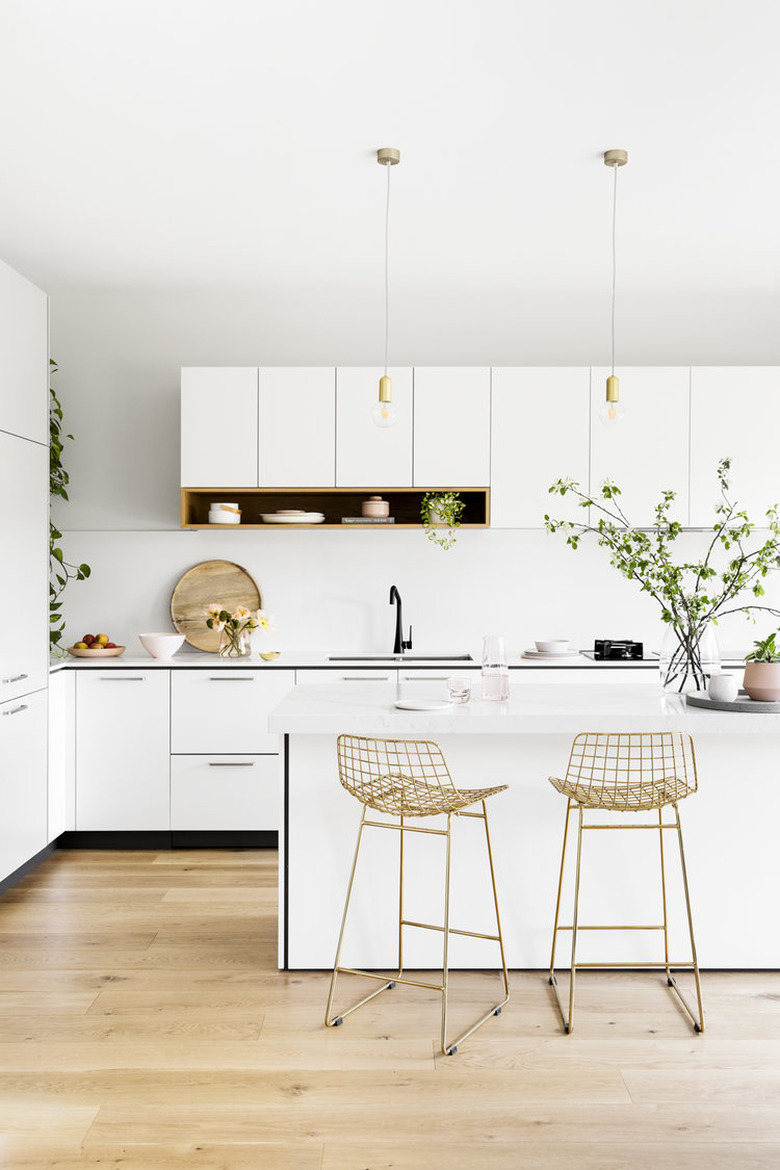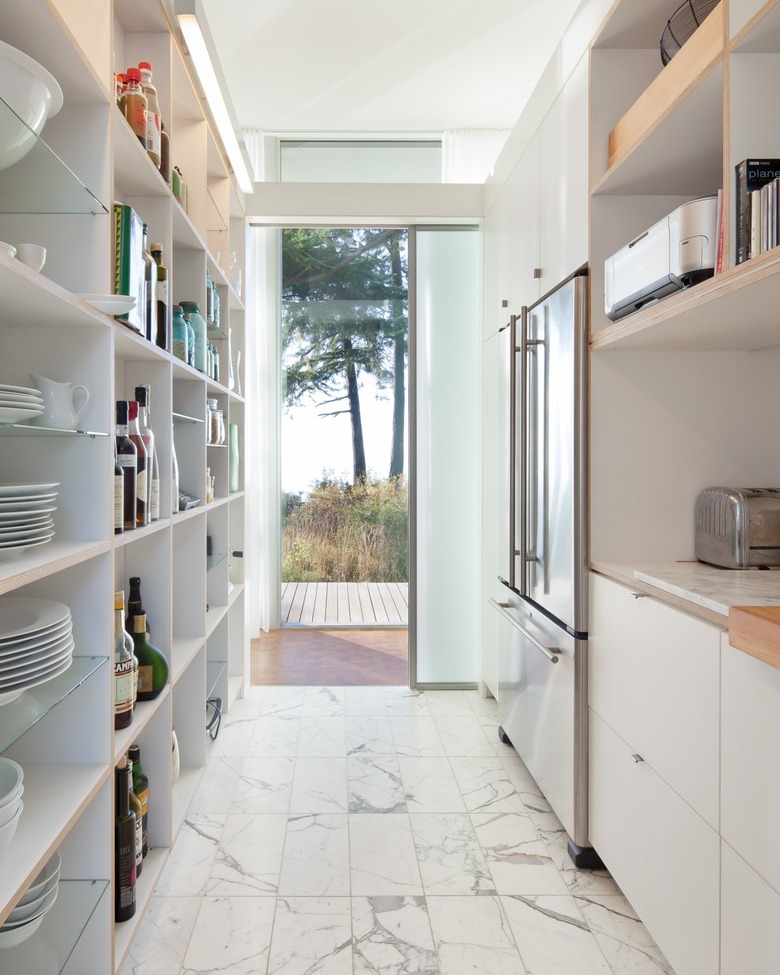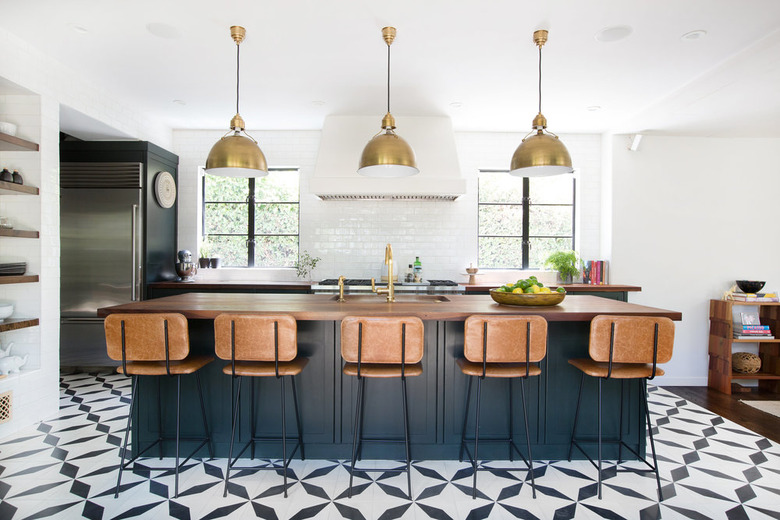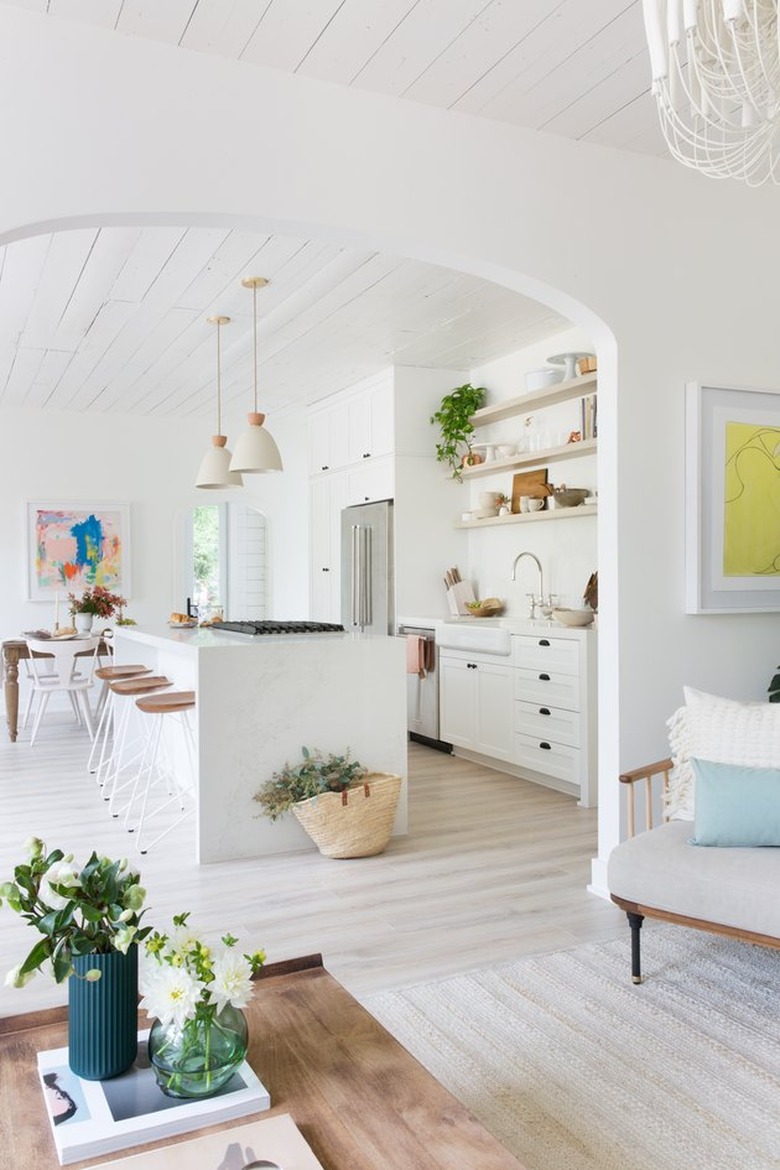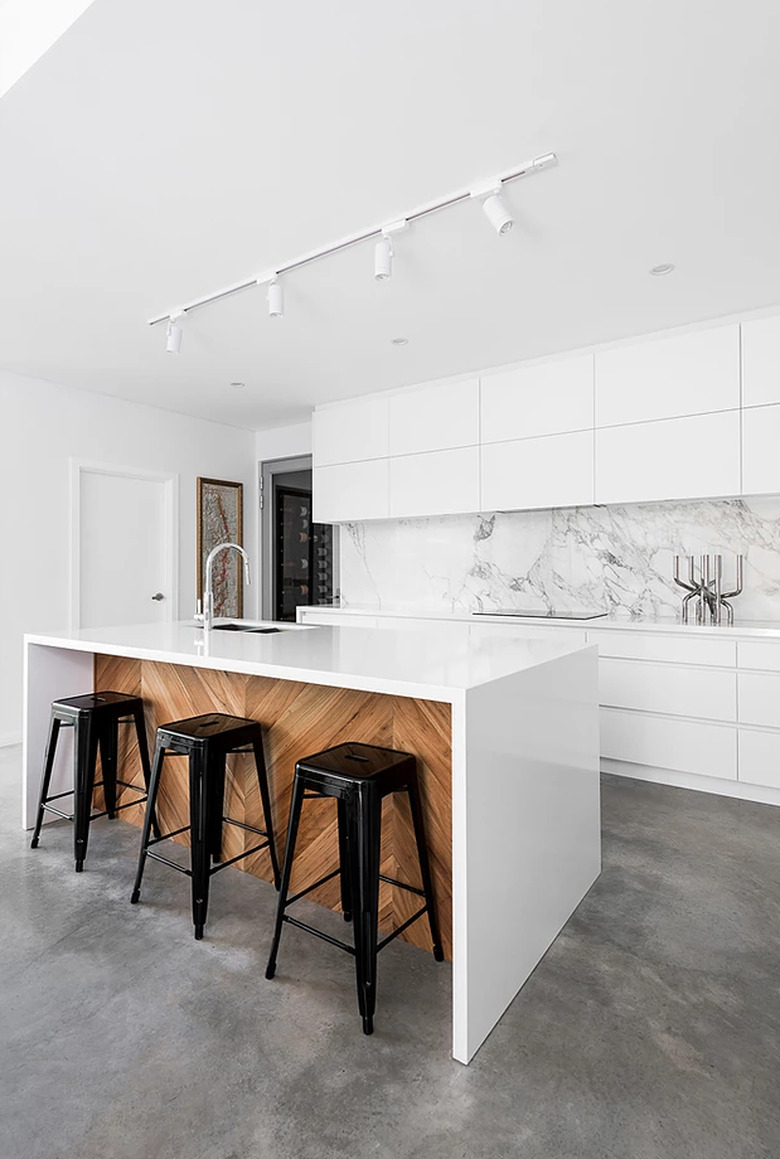Kitchen Flooring Ideas & Inspiration
When you envision your dream kitchen, you've probably imagined everything that you can see at eye level: exquisite white cabinets, a farmhouse sink, and vintage wall art. Now, shift the view of sight in that daydream slightly lower ... what's below your feet. Take some time to visualize picture-perfect kitchen flooring as well.
The floor is a bigger deal than you may think. Not only does it ground the look and feel of your kitchen, but you also have wear, durability, and maintenance to consider. There's also that little thing known as the bottom line for your budget.
We've broken down some of the most popular types of kitchen flooring available today, along with some essential info to help you choose the ideal material for your culinary headquarters.
1. Marble, Limestone, Travertine, and Slate Kitchen Flooring
1. Marble, Limestone, Travertine, and Slate Kitchen Flooring
Marble has always been an elegant, timeless, and luxurious choice for kitchen flooring. With so many varieties to choose from (Carrara, Calacatta, and Crema to name a few), you are guaranteed to have a truly one-of-a-kind looking space when you opt for this material. Bonus: it's an eco-friendly choice, but keep in mind that it will require a lot of maintenance —especially since it's somewhat prone to stains and scratches.
The marble tile in the galley kitchen of this beachside home, designed by the team at Heliotrope Architects, shines thanks to its distinct gray veining.
Limestone rock formations in nature are certainly pretty to look at, and as it turns out, limestone kitchen flooring is beautiful to behold as well. It tends to be less expensive than other natural stone options, plus the look is guaranteed to be one-of-a-kind if that's a priority in your space. And, like any stone surface, expect to reseal it from time to time for optimal protection against wear, tear, and stains.
Another limestone option is travertine, which is starting to head to the top of the kitchen flooring heap. It can be on the porous side, and that translates to scratches and stains if it isn't properly sealed. But when it is sealed, expect oh-so-easy maintenance with just a little soap and water. We love the warm look it brings to culinary spaces.
Black slate is all the rage these days when it comes to kitchen backsplashes, but homeowners are also using the material on their floors as well. There are certainly more pros than cons if you're considering slate. It's an amazingly strong material, it has texture for days, which adds visual interest, and out of the natural stone options, it can really withstand stains. Just know that it might hit your wallet a bit harder than other types of flooring.
2. Ceramic, Porcelain, and Cement Kitchen Flooring
2. Ceramic, Porcelain, and Cement Kitchen Flooring
Treated with heat and oftentimes a glaze, ceramic tile is a beloved standard in kitchens everywhere. You'll have plenty of colors and patterns to choose from (just know that sometimes those colors can differ between lots), it's straightforward to install, and it won't be hard on your budget. People also praise it for its ability to be cleaned easily. With a little TLC, your ceramic tile will look just as flawless as the black and white option from Clé Tile selected for this lovely kitchen.
Porcelain tile is in the ceramic tile family, but it differs slightly because it tends to be harder and more durable. With its heavy glaze, it can resist stains like a pro and lasts for years. Although it can be on the expensive side, we think it's worth the investment.
Cement tile has been gaining steam for the last few years. Made of — you guessed it — cement, this material has a matte look and often appears in punchy, eye-catching patterns. But since it's porous, it can be prone to stains, which is pretty much inevitable in a kitchen. Experts recommend sweeping it regularly and washing it with a pH-neutral soap, especially if there's a spill to clean up.
3. Laminate, Vinyl, and Linoleum Kitchen Flooring
3. Laminate, Vinyl, and Linoleum Kitchen Flooring
The trifecta of classic kitchen flooring options are typically: laminate, vinyl, and linoleum. Each of them have their strengths and weaknesses and can look surprisingly fresh and visually appealing, proven by the laminate flooring seen in this culinary space belonging to Camille Styles.
Laminate flooring is composed of a series of layers that create increased durability for your kitchen. It can be fairly easy to install (especially if it's a tongue-and-groove style) and it's certainly easy on the budget. Standard laminate flooring can show stains after spills, so it might be wise to purchase the waterproof version, which is slightly more expensive.
Although the word "linoleum" might elicit a cringe or two, we actually think it can be quite stylish in a kitchen. If you're going for a retro vibe, linoleum flooring can look spot-on. It's very reasonably-priced and requires little maintenance (as long as you're vigilant about cleaning up spills right away).
Lastly, you can always choose the removable wallpaper version of kitchen flooring: vinyl. With peel-and-stick options available nowadays, vinyl flooring is a smart choice in a rental kitchen where you may want to change up the aesthetics. It's low-priced, and like laminate and linoleum, it's pretty straightforward to keep it clean and looking its best.
4. Concrete, Brick, and Terra Cotta Kitchen Flooring
4. Concrete, Brick, and Terra Cotta Kitchen Flooring
If tile isn't really your thing, you have plenty of other flooring options at your disposal. Equal parts industrial and modern, a polished concrete floor looks surprisingly au courant in a cook space. It's inexpensive, you can stain it in a wide array of hues, plus it's simple to care for. Don't forget to seal your flooring though — this industrial material can be predisposed to nicks, scuffs, and scratches. It looks ultra chic in this bright modern kitchen design by Sandy Anghie.
If you want a cook space that looks as if it's from another era, look no further than a rustic brick floor. Brimming with old-time charm, it's a strong material that will stand up to heavy traffic and wear. However, it can soak up stains, so make sure that it's sealed correctly. And since it can get a little chilly during the winter season, we recommend cozying it up with a rug or two.
Terra cotta decor is frequently spotted in bohemian homes, but the material can also be used as an earthy kitchen flooring option. As a baked ceramic, terra cotta has literally been around for centuries and still looks fab in homes today. It's extremely strong, but to be on the safe side, you should definitely seal your floors. It's also cost-effective, which should be music to your ears if you're planning a budget reno.
5. Hardwood and Bamboo Kitchen Flooring
5. Hardwood and Bamboo Kitchen Flooring
Hardwood is another gold standard when it comes to kitchen flooring ideas — or flooring throughout an entire home for that matter. You'll have a range of wood species to choose from, and it will look beautiful for years and years to come, even as trends come and go. But since it is vulnerable to water damage, it may require a little extra maintenance and should be refinished from time to time to keep it looking its best. The warm hardwood flooring in this bright culinary space, designed by Cantilever Interiors, is the ideal finishing touch amid a sea of white cabinets.
For a different look in your kitchen, give some thought to bamboo kitchen flooring. It usually costs a bit less than hardwood styles, but it is prone to warping if water and spills are not cleaned up immediately. The material itself is also very eco-friendly.
Additional Things to Consider
Additional Things to Consider
Now that we've presented a few kitchen flooring ideas, there are other things to think about before you take the leap and purchase the material. First of all, ponder your lifestyle. Will your kitchen be filled with dirty paws, gathering friends, and the pitter-patter of little feet? In that case, choose durability over style (and rest easy knowing that most of the time, you can bring those two things together easily).
Match the palette and style of your kitchen. Brick and concrete floors tend to blend seamlessly with industrial, farmhouse, or vintage-inspired spaces, while marble or cement tiles are a flawless fit in modern spaces.
How much time do you have to devote to the maintenance of your floor? Are spills and stains common in your kitchen? If the answers are "Not a lot of time" and "Yup, very, very common," you'll want to consider something like porcelain tile or another hardy material that can be wiped down quickly without a lot of fuss.
Lastly, you'll want to work out a budget before you go shopping. While ceramic tile and concrete flooring are usually reasonably-priced, be forewarned that stylish porcelain, marble, cement, or hardwood flooring will hit your wallet a bit harder. If you're drawn to unique glazes and uncommon patterns, those will usually add on to the price tag, too.
